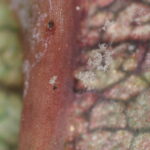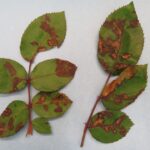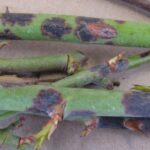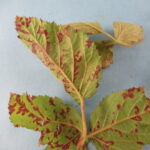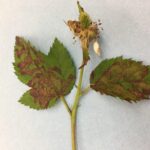- Figure 1: Sparse downy mildew spore production on the underside of a rose leaf
- Figure 2: A highly magnified view of downy mildew spores on rose
- Figure 3: Downy mildew symptoms on rose leaves showing red and purple spots
- Figure 4: Downy mildew symptoms on rose leaves
- Figure 5: Downy mildew lesions on rose stems showing purple or black blotches
- Figure 6: Downy mildew symptoms on blackberry
- Figure 7: Downy mildew symptoms on a bramble
Cool, cloudy weather with frequent rainfall and high humidity provides ideal conditions for the development of several diseases, including downy mildew. The fungus-like pathogens that cause downy mildew are commonly known as ‘water molds’ and are classified as oomycetes. Many types of plants are susceptible to downy mildew diseases, including sunflowers, grapevines, impatiens, other ornamentals, and several vegetable crops. Perhaps the downy mildew diseases of greatest concern in the landscape and home garden are those on rose, raspberry, and blackberry, all caused by Peronospora sparsa. The name ‘sparsa’ stems from the fact that spores of the pathogen are often difficult to find and may not be present unless conditions are right. Figure 1 shows sparse spore production on the underside of a rose leaf. A highly magnified view of downy mildew spores on rose is shown in Figure 2.
Downy mildew of rose and bramble crops is of particular concern because the pathogen becomes systemic inside the plant, not just affecting leaves. Symptoms may appear rapidly in spring, with angular-shaped necrotic leaf spots amid yellow areas (Figures 3 and 4). Black and/or purple spots develop on petioles and stems (Figure 5), and roses may partially defoliate, while new buds of raspberry and blackberry may sprout out and then die rapidly. On some brambles, the leaves may develop a mottled appearance that may be mistaken for a virus disease (Figures 6 and 7).
Management: Start by purchasing healthy plants from a trusted source to avoid bringing in infected material. Store plants in well-ventilated areas until planting and avoid overhead sprinkler irrigation where practical. Stems with downy mildew symptoms should be pruned out as they develop. In addition to persisting in infected stems the pathogen may overwinter in debris so fallen leaves and stems should be removed from the landscape promptly but avoid working in plants when they are wet. Spacing plants for good airflow may help reduce humidity to some degree. Spores may spread by air movement or water splash. Fungicides labeled for downy mildew control are commonly used in greenhouse and nursery rose production but are not generally recommended in the landscape.
